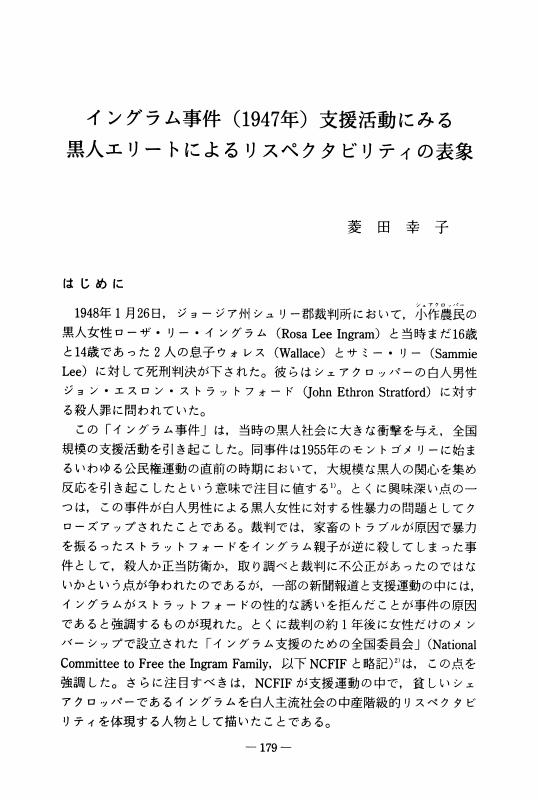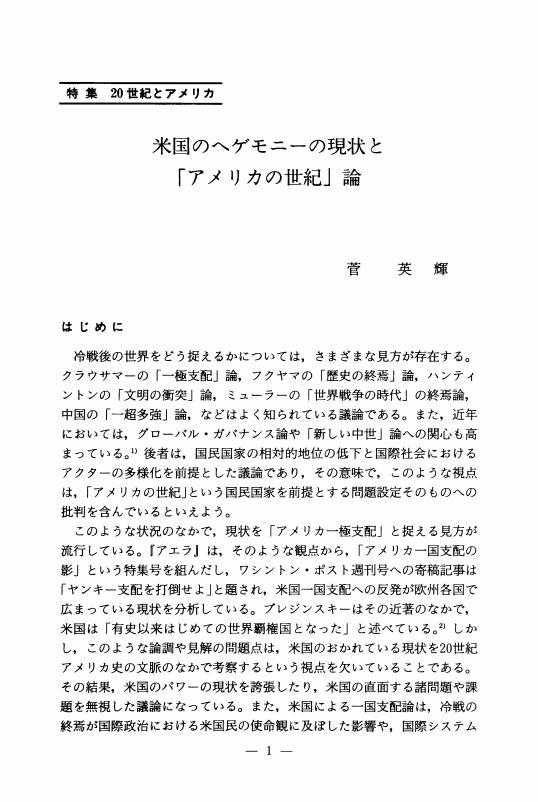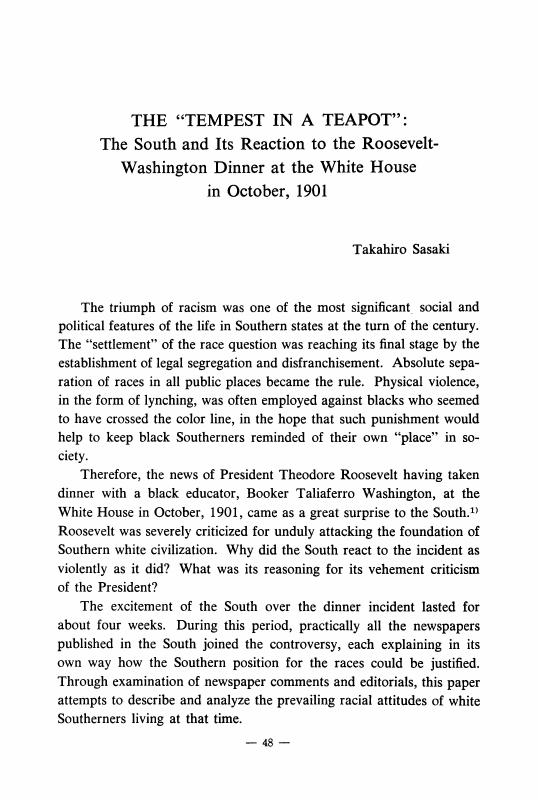- 著者
- 武田 寿恵
- 出版者
- アメリカ学会
- 雑誌
- アメリカ研究 (ISSN:03872815)
- 巻号頁・発行日
- vol.55, pp.121-139, 2021
<p>Julie Taymor's production of <i>The Lion King</i>, for which she would become the first woman to win a Tony for Best Direction of a Musical, opened at Broadway's New Amsterdam Theatre in 1997. To recreate this story of savannah animals on the stage, Taymor devised a method that she called "the double event," in which each character was simultaneously expressed by an actor's body and an animal mask or puppet. Because the actors' faces were not hidden from the audience by the masks, their skin colors were closely associated with the characters they portrayed. Skin color is a racial characteristic that is easy to identify visually. As Stephanie Leigh Batiste has pointed out, in her book <i>Darkening Mirrors</i>(2011), the skin color of African-American actors becomes part of their performance, especially in the theater. Recognizing this, Taymor deliberately cast African and Black actors, using "color-conscious casting," which consciously incorporates actors' racial characteristics as production elements. By presenting the "color" of African actors to audiences in this way, she embodied an important theme of the musical: "the power of Africa."</p><p>By contrast, the "color" of the white actors was rendered indistinguishable through facial makeup. This paper pays particular attention to the villain Scar, who is typically played by a white actor. Just as in the film on which the musical was based, Scar was the only lion who spoke with a British accent. He was depicted as a "white presence" with a stereotypical Shakespearean actor's performance style and mannerisms. In his book <i>The Great White Way</i>(2014), Warren Hoffman has argued that the "white people" who appear in most Broadway musicals are positioned as a raceless norm that cannot engender racial problems. By using makeup to paint Scar, the "white presence," brown, Taymor made it impossible for audiences to interpret Scar as a "white person."</p><p>This paper refers to the three-layered structure assigned to <i>The Lion King'</i>s white actors—actor body, animal mask, and artificial color—as "the triple event." In doing so, it demonstrates how skillfully obscuring the color of white actors can effectively force "color-blind casting." By deliberately combining color-conscious casting for Black actors with forced color-blind casting for white actors, Taymor created a phenomenon that can reasonably be considered a form of "reverse racism," as described by Anne Nicholson Weber in <i>Upstaged: Making Theatre in the Media Age</i>(2006) In disguising the color of white actors, the triple event became a pioneering staging method, serving to overturn the racial privilege of white actors.</p>
- 著者
- 山本 みどり
- 出版者
- JAPANESE ASSOCIATION FOR AMERICAN STUDIES
- 雑誌
- アメリカ研究 (ISSN:03872815)
- 巻号頁・発行日
- vol.1980, no.14, pp.112-140, 1980
- 著者
- 辻 秀雄
- 出版者
- アメリカ学会
- 雑誌
- アメリカ研究 (ISSN:03872815)
- 巻号頁・発行日
- vol.43, pp.115-134, 2009
<p>As American Studies begins to address such fundamental questions as how America can be defined spatially, culturally, and conceptually in the age of globalization, it has become apparent that more international and transnational approaches are needed. This essay shares that same awareness as it reinvestigates Ernest Hemingway's hardboiled style, which has been traditionally evaluated as quintessentially American. Through a careful rereading of <i>A Farewell to Arms</i>, it argues that this hardboiled style was born, by contrast, in a transnational and thus "extraterritorial" environment.</p><p>The essay begins by recontextualizing the oft-discussed passage in <i>A Farewell to Arms</i> where Frederic Henry denounces abstract words. There it becomes clear that his "hardboiled" denunciation of abstract words is connected at a deeper level to the transnational situation in which he finds himself. Prior to this interior monologue, he is talking with an Italian soldier, Gino. Although the novel is mostly written in English, including this scene depicting Henry's conversation with Gino, it should be noted that the conversation was actually held in Italian, evidenced by the fact that Italians with some exceptions do not speak foreign tongues in the novel and that Henry is fluent in Italian. This indicates Henry is switching languages: he has been using Italian when talking with Gino and hearing his patriotic diction, but then switches to English during his interior monologue. This language switching brings to the fore a new aspect of Henry's problem with abstract words: he feels much more separate, in English, from them. His problem, in other words, is augmented by translation.</p><p>The theory of translation explored by Walter Benjamin and his critics sheds new light on the structure of <i>A Farewell to Arms</i>, a novel consisting of two stories: 1) a war story in which the American Henry fights in an Italian army, and 2) a love story in which he escapes from war into a romantic relationship with an English nurse, Catherine Barkley. What becomes apparent is that, while in the war story Henry is in a transnational environment, retaining a sort of dual nationality, in the love story his relationship with Catherine becomes monolingual. The difference implies the superior quality of his affinity with Catherine relative to his extraterritorial status in the war story. Moreover, the affinity he feels toward Catherine has strong parallels to the relationship that exists between language and its native speaker. However, the irony of the novel reveals itself at the end with the death of both Catherine and the baby, making Henry keenly aware, once again, of the delusive nature of the sense of unity one feels with his/her native tongue.</p><p>By incorporating Benjamin's concept of "pure language," this essay explores the way these two stories in <i>A Farewell to Arms</i> supplement each other to connote a utopian horizon for literature where the representational function of language disappears and language becomes itself. The essay concludes that the hardboiled quality of Henry's language and attitude suggests a desire for this utopian horizon, despite its tough, individualistic appearance</p>
1 0 0 0 OA 灰と火花: アメリカ詩と日本の現代詩
- 著者
- 新倉 俊一
- 出版者
- アメリカ学会
- 雑誌
- アメリカ研究 (ISSN:03872815)
- 巻号頁・発行日
- vol.1973, no.7, pp.66-84, 1973-03-15 (Released:2010-06-11)
1 0 0 0 OA アメリカ国務省による初期戦後対日政策の形成について その海軍戦略理論からの離脱過程
- 著者
- 森田 英之
- 出版者
- アメリカ学会
- 雑誌
- アメリカ研究 (ISSN:03872815)
- 巻号頁・発行日
- vol.1978, no.12, pp.132-145, 1978-03-25 (Released:2010-09-28)
- 参考文献数
- 52
1 0 0 0 アメリカ宗教における個人と組織:60年代以降を中心として
- 著者
- 生駒 孝彰
- 出版者
- アメリカ学会
- 雑誌
- アメリカ研究 (ISSN:03872815)
- 巻号頁・発行日
- vol.1984, no.18, pp.47-66, 1984
- 著者
- 田中 久男
- 出版者
- アメリカ学会
- 雑誌
- アメリカ研究 (ISSN:03872815)
- 巻号頁・発行日
- no.40, pp.39-56, 2006
This article is an attempt to explore the structured violence in the South as a form of culture, focusing on such an actual outburst of violence as the Emmett Till case and on William Faulkner's "Dry September" (1931) as a fictional rendering of it. In The American Way of Violence (1972) Alphonso Pinkney detects the strong connection between American Calvinism and the Social Darwinism which helped to advance the tendency of American society to dichotomize human society into two groups such as the saved and the damned, the superior and the inferior, or the good and the evil—a dichotomization which was taken advantage of to justify black slavery and the massacre of Native Americans. William Styron presents in his masterpiece, Sophie's Choice (1979), the idea of the two greatest absolute evils in human history, which, in his view, were materialized in black slavery and theholocaust: the slavery as a collective social enforcement of white supremacy and the holocaust as an outcome of the 'overdetermination' of many social influences, that is, a composite agency of anti-Semitism and other factors such as religion, economics, politics, or nationalism.This article first highlights an episode in Ernest Hemingway's The Sun Also Rises (1926) in which Robert Cohn was awakened to his Jewish identity and the latent habitus of anti-Semitism at Princeton. We see the same kind of awakening in the Jewish character Nathan Landau in Sophie's Choice, who seems in the end to be crushed by the huge dogma of anti-Semitism. We can recognize the tremendous violence of anti-Semitism in society from the ordeal which the young Lionel Trilling experienced as a Jew at Princeton. In the same vein, we can see the agony of Franz Fanon's Black Skin, White Masks (1967), a work that makes a splendid analysis of the great bias of European Christian culture towards regarding the color black as a stigma, as it is closely connected with Satan, evil, immorality, or darkness—a bias which, in association with the concept of the great chain of being, seems greatly responsible for the view of black people as racially inferior in the human scale. Toni Morrison also draws our attention to such problems as "the pain of being black" in tightly racialized American society which had been shaped not only by the prevalence of Social Darwinism in the late nineteenth century but also by the enforcement of the Jim Crow laws and the twisted interpretation of the Bible endorsed by the idea of white supremacy.The murder of Emmett Till, a fourteen-year-old black boy from Chicago, by two white supremacists, which took place in Money, Mississippi, in the summer of 1955, is symbolic of the structured violence, which resembles a Southern version of Louis Althusser's idea of "Ideological State Apparatuses" and which is based on the racial fanaticism peculiar to the Deep South. Morrison wrote a play entitled Dreaming Emmett, with the hope that the white and the black could make the nightmare their common memory. William Faulkner wrote a letter of grief and lamentation about this case to a newspaper, deploring the irredeemable violent bigotry of his native soil. In "Dry September" Faulkner describes such bigotry in a Southern small town as revealed in the ex-soldier's effort to maintain "the power structure in which they 'protect' women and terrorize blacks." Nevertheless, we should feel the shock of recognition, as if we were dazzled by the deep chasm between actuality and fiction, when we read his mysterious 1931 letter published in the Memphis Commercial Appeal, a letter saying that lynch mobs "have a way of being right."
1 0 0 0 OA イングラム事件 (1947年) 支援活動にみる黒人エリートによるリスペクタビリティの表象
- 著者
- 菱田 幸子
- 出版者
- アメリカ学会
- 雑誌
- アメリカ研究 (ISSN:03872815)
- 巻号頁・発行日
- vol.2004, no.38, pp.179-197, 2004-03-25 (Released:2010-10-28)
- 参考文献数
- 68
- 著者
- 金澤 智
- 出版者
- アメリカ学会
- 雑誌
- アメリカ研究 (ISSN:03872815)
- 巻号頁・発行日
- vol.1999, no.33, pp.191-208, 1999
1 0 0 0 OA 米国のヘゲモニーの現状と「アメリカの世紀」論
- 著者
- 菅 英輝
- 出版者
- アメリカ学会
- 雑誌
- アメリカ研究 (ISSN:03872815)
- 巻号頁・発行日
- vol.1999, no.33, pp.1-18, 1999-03-25 (Released:2010-10-28)
- 参考文献数
- 46
1 0 0 0 『精選マクガフィー読本』にみる19世紀アメリカの学校教育の歴史
- 著者
- 藤本 茂生
- 出版者
- アメリカ学会
- 雑誌
- アメリカ研究 (ISSN:03872815)
- 巻号頁・発行日
- vol.1995, no.29, pp.59-75, 1995
- 著者
- 石塚 則子
- 出版者
- アメリカ学会
- 雑誌
- アメリカ研究 = The American review (ISSN:03872815)
- 巻号頁・発行日
- no.54, pp.45-66, 2020
- 著者
- 増井 志津代
- 出版者
- アメリカ学会
- 雑誌
- アメリカ研究 = The American review (ISSN:03872815)
- 巻号頁・発行日
- no.54, pp.21-43, 2020
1 0 0 0 OA ハワイ島における民間仏教歌伝承 欠落をイメージに希求する女性たち
- 著者
- ウェルズ 恵子
- 出版者
- アメリカ学会
- 雑誌
- アメリカ研究 (ISSN:03872815)
- 巻号頁・発行日
- vol.2004, no.38, pp.103-122, 2004-03-25 (Released:2010-10-28)
- 参考文献数
- 13
1 0 0 0 OA クェーカー教徒と奴隷制反対運動
- 著者
- 山形 正男
- 出版者
- アメリカ学会
- 雑誌
- アメリカ研究 (ISSN:03872815)
- 巻号頁・発行日
- vol.1971, no.5, pp.178-196, 1971-03-31 (Released:2010-06-11)
- 参考文献数
- 75
1 0 0 0 OA 子どもの発見-G・スタンレー・ホールの「児童研究」をめぐって
- 著者
- 朝日 由紀子
- 出版者
- アメリカ学会
- 雑誌
- アメリカ研究 (ISSN:03872815)
- 巻号頁・発行日
- vol.1995, no.29, pp.77-94, 1995-03-25 (Released:2010-10-28)
- 参考文献数
- 34
- 著者
- Takahiro Sasaki
- 出版者
- THE JAPANESE ASSOCIATION FOR AMERICAN STUDIES
- 雑誌
- アメリカ研究 (ISSN:03872815)
- 巻号頁・発行日
- vol.1986, no.20, pp.48-67, 1986-03-25 (Released:2010-10-28)
- 参考文献数
- 81
1 0 0 0 OA パフォーマティヴ・ジェンダーの行方 パティ・スミス論
- 著者
- 當間 麗
- 出版者
- アメリカ学会
- 雑誌
- アメリカ研究 (ISSN:03872815)
- 巻号頁・発行日
- vol.2003, no.37, pp.177-198, 2003-03-25 (Released:2010-10-28)
- 参考文献数
- 46
1 0 0 0 OA タウンとガウンの関係 イェール大学の場合
- 著者
- 児玉 佳与子
- 出版者
- アメリカ学会
- 雑誌
- アメリカ研究 (ISSN:03872815)
- 巻号頁・発行日
- vol.1971, no.5, pp.153-177, 1971-03-31 (Released:2010-06-11)
- 参考文献数
- 82
1 0 0 0 アメリカの対日占領政策における民法改正:女性の法的地位をめぐって
- 著者
- 土屋 森口 土屋 由香
- 出版者
- アメリカ学会
- 雑誌
- アメリカ研究 (ISSN:03872815)
- 巻号頁・発行日
- vol.1995, no.29, pp.155-176, 1995









